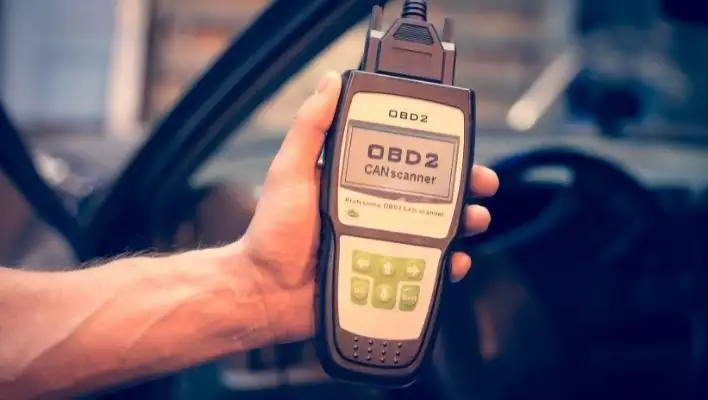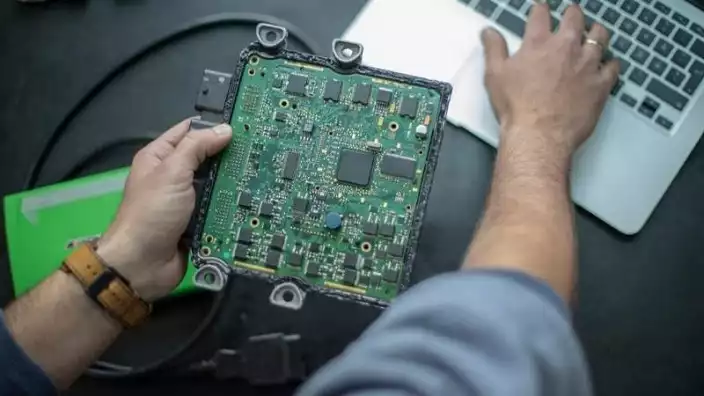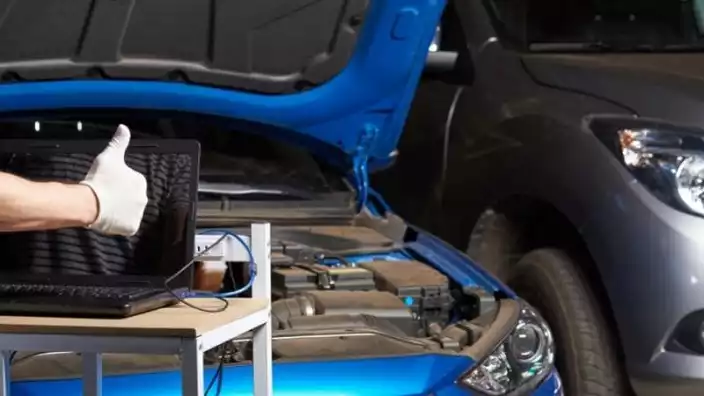If you are thinking about how to test ECM computer, you come to the right place because today I will show you how to test ECM computer by yourself. And you can test the car computer at home.
When an auto repair shop costs you high for engine control module testing, learning how to test your car computer will save you money and time. Regular ECM tests will help your car to run properly on the road.
That’s why you should learn the whole process of testing an ECM computer in your car.
When you know how to test the ECU, you will be able to know what causes your ECU to go bad and you also be able to know common symptoms of a bad ECU. Some tools and indications will help you to diagnose ECM computer.
How To Test ECM Computer
Scanner and visual inspection is the most common method to test ECM computer. Using a scanner, you can find out your car engine code, which will show you ECM computer testing results. There are also other ways to test ECM computer or car computer, some of which are a simple swap, checking the battery, and the Elimination process.
With all of these ways, you can test your car ECM computer. You can even test ECU with a multimeter which is not so hard.
You better remember, ECM Computer, car computer, Engine control module computer are the same, people say what they are accustomed to.
People get confused to understand the difference between ECU and ECM or PCM or TCM, which is not really hard to understand. For every version of ECM computer resetting and testing processes are the same.
So, if you learn how to test a car computer in your car, you will be able to help others to do it and save their money.

Here are five useful ways to test ECM computer:
- OBD or OBD II code scanner
- Visual Inspection
- Car Battery Check
- A Swap
- Process of Elimination
1. OBD or OBD II Code Scanner

As a car owner, you should know what an OBD code scanner is. Onboard Diagnostic (OBD) is an engine code scanner that can access vehicle data.
OBD scanner is used to check the car vehicle engine and communicate all the possible glitches in the vehicle.
Every car owner should have an OBD code scanner in the vehicle. After 1996 automobile manufacturers began using Onboard Diagnostics II (OBD2), a diagnostics system in the vehicle.
Testing ECM computers would be really easy if you use OBD II for testing. Personally, I always test my car’s ECU computer using this OBD II scanner because it’s an easy and precise method to do it.
Onboard Diagnostic (OBD or OBD II) scanner manufacturers are constantly updating OBD II scanners for better performance.
To test an ECM computer or car computer, you need to bring an Onboard Diagnostic (OBD or OBD II) scanner tool.
Connect the OBD II scanner tool to the diagnostic port of your car, which will let you know whether or not there are any issues in your car by codes.
When an Onboard Diagnostic (OBD or OBD II) scanner shows you codes, you need to understand those codes to fix issues in your car.
Some of the common codes may be shown in your OBD II scanner:
- P0700 Code:
The P0700 code means there is an error in your Transmission Control Module (TCM). TCM issues in your car are different from ECU or car computer. But, in the vehicle TCM/PCM/ECM or ECU, these issues are quite similar. If your OBD II scanner shows the P0700 codes, then you should avoid being driven.
- P0602 Code:
Engine module programming issues can occur in a vehicle. The P0602 code says that there are programming issues in the Engine Control Unit (ECU). To fix the P0602 code in your car, you may need to reprogram or reflash the ECU computer. On this P0602 code issue, you can get help from a professional.
- P0600 Code:
The P0600 code indicates your car’s ECU has lost the connection with one or more sensors. Low battery voltage also can be another issue that makes the P0600 Code. That’s why you should check every sensor connection with the engine control module and battery voltage.
- P0606 Code:
Faulty ECM/PCM brings the p0606 code to your car. If any internal issues can be found, the OBD II scanner will bring this code. If the OBD II scanner displays the P0606 code, you need to check the powers and grounding to verify or fix this code issue.
2. Visual Inspection

In order to test an ECM computer, you have to do a visual inspection around the ECM computer. When you start visual inspection on your car computer, the first thing to see is PINs.
If you see ECM computer’s PINs are good and intact. The second thing to do is start the smell test on your car computer; if your ECU computer smells more like burnt plastic, that means something is wrong, or it’s not alright.
For further visual inspection to test the ECU computer, you might need to open up the Engine Control Unit (ECU) board for further visual inspection. Try not to hurry when you open up the ECU board.
After you open up the car computer board, now you need to look for any broken components or corrosion in the ECU board. After opening up the ECU board, If you see any broken components or corrosion, the ECU computer will need to be replaced.
3. Car Battery Check
Knowing the battery voltage can help you to test ECU computer because your ECU can’t work properly when the battery voltage is too low.
The sensors connected to your car ECU computer cannot make the correct adjustment when your battery voltage is low or not right.
The car battery needs to be fully charged when you drive on the road. Check your car battery voltage using a multimeter with the engine off and engine on.
If you read 12.6 volts with the car engine off and 13.7 volts with the engine on, this looks good, and your battery is fully charged.
If you read less than 12.6 volts with the car engine off and 13.7 volts with the engine running, you should recharge the battery and re-test the voltage with a multimeter.
4. A Swap
A swap is only effective for older cars. Before 1996 car manufacturers made cars with Onboard Diagnostic (OBD I), which did not require programming.
So if you are driving an old car made before 1996, then with a simple swap, you can test the car ECM computer.
To swap to your car, first, you need to find a replacement unit that matches the original part number.
And after you put the replacement unit in your vehicle and communicate, that is a certain indication that tells your car’s unit that it needs to be replaced.
Remember, this car computer testing process is only for old cars containing OBD I, not modern cars.
5. Process of Elimination

To diagnose the car computer, the process of elimination is a very useful way. By elimination process, you will check almost all of the car’s components, letting you know the current car’s components situation.
The process of elimination is done by checking the car’s Inputs and Outputs. That’s why you should take the time to test the ECM computer by process of elimination.
The car’s Input contains the Ignition Switch, the Fuses, the Battery, and the Sensors. On the other hand, Output contains the Spark Plugs, the Starter, and the Injector. These are the components that will need to be checked to test a car computer.
We will need to check each input unit for input units or components for any voltage efficiency and wire connection to the car computer. In input process elimination, The battery has a major role.
That’s why first you need to check the battery voltage to the engine computer, as it provides a sufficient amount of voltage through the ignition switch, through the sensors, and the fusses because the battery produces voltage to the Engine computer through these input units.
When you see the car computer gets the proper voltage from the battery. Now you need to see if the output units are working properly or not.
Ensure the Injector, the Starter, and the Spark Plugs get the right signal from the ECM computer.
After you test all of these output units, you see output units are not getting the proper signal, which means your car computer is bad or not working correctly.
Most Common ECM Failure Symptoms
Proper knowledge about your car ECM computer will help you to maintain your car properly.
When you test your car ECM computer or car computer, you also need to understand the engine computer failure indication.
Most of the time, it’s hard to notice the sign of ECM failure in a car. But below, you will see some of the most common ECM failure symptoms in a vehicle.
Here are the most common ECM failure symptoms:
- Car won’t start
In most cases, if your car has an issue with the ECM computer, it won’t be able to start. Whether you put the key in the ignition, try to start the engine, or try to jump-start the engine. That’s why if you notice your car hiccups during startup or the car won’t start after trying, which tells your ECM is not right.
- Check engine light on
Checking the check engine light is one of the easiest ways to understand the symptoms of ECM failure. For many reasons, check engine light can be on, but most of the time, it’s on for the engine computer’s fault.
- Rough Shifting
You may know that ECM is collecting data on your car’s other components to maintain them properly. If ECM collects bad data and sends it to the Transmission Control Module (TCM), the TCM can’t get the right data to operate car shifting, and eventually, car shifting will be rough.
- Engine Stutters or Misfires
If you notice your car engine stutters or misfires, your car’s ECM computer is not working currently or has failed completely. You shouldn’t ignore engine stutters or misfires issues because it can cost you a lot if you don’t take any steps immediately.
Can You Test Your ECM At Home?
Testing a car ECM computer requires specialized knowledge, tools, and software. So, if you have proper knowledge about testing an ECM, program software, and tools, you can test your ECM at home without any difficulty.
And if you don’t know much about ECM computer or have no experience, you should first need to learn the ECM testing procedure from a professional or an experienced person.
A professional knows the proper way to test an ECM computer, and if you learn the process once, you should be able to test ECM by yourself at home.
You better remember An ECM is one of the essential components to run the car. And an ECM computer is an expensive part of your car.
Anything goes wrong with the ECM computer during the test; it would need to replace. That’s why if you don’t have enough knowledge or experience, you should leave the testing ECM to a professional.
Frequently Asked Questions (FAQ)
How much does it cost to replace ECM?
The average cost to replace ECM is around $1000 before taxes and fees; a new engine control module (ECM) costs you $700 to $900, and labor costs between $85 to $150. But, you should keep in mind that Labor costs and a new ECM purchase cost can also depend on your state.
Can ECM be repaired?
Repairing an ECM depends on the issues with your ECM. If your ECM computer’s software or code is going bad, it can be repairable, but if your ECM computer board is broken, then it won’t be repaired; you have to change the ECM.
Can I replace an ECM myself?
You can replace an ECM by yourself. Replacing an Engine Control Module (ECM) is simple, and you don’t need to know too much about it. But, before you replace the ECU or ECM, you should know the proper procedure to replace the ECM computer in your car.
What happens if you unplug the ECU?
If you unplug or disconnect the ECU, the vehicle won’t run because an ECM is the brain of a vehicle. The engine control unit (ECM) controls some of the main parts of your car’s operating system: Fuel injection, idle speed, and ignition timing. That’s why without an ECU, the car cannot be running.
Does a new ECU need to be programmed?
A new ECU needs to be programmed into your vehicle because the ECU computer needs to be programmed for your car’s model and make. Some modern garages have the tools to swap the old ECU program to the new ECU, but you might not get these tools in a typical garage.
Final Thoughts
By following these ways, you can test ECM computer. With an Onboard Diagnostic (OBD) scanner, testing a car computer is so easy. After testing your ECM computer, you should come up with a certain result of your ECU.
ECM computer testing is necessary for your car. But if you want to test your car ECU computer, you have to have some specialized knowledge and experience of testing an ECM computer.
The most important thing is to diagnose the main issues in your ECM computer because the problem is staying in your car would be bad for your vehicle.
No matter how you test the engine control module, finding the right issues in your car is the main job.
So, if you don’t have proper knowledge about testing ECM computer, you should learn from a professional.
If you are testing the ECM computer and found the main culprit, then it’s better to go to an auto repair shop or a professional to take proper steps about your car computer.

Hey there,
How is it going?
I’m Meraj Sarker. I am a Car Mechanic and a student of Automobile Restoration here in Florida, USA. I’ve been studying automotive for around 9 years now. So you can rely on my recommendation. For me, studying and getting knowledge about automobile it’s really fun and entertaining. I will help you to get solutions for your car through this website. If you need any help let me know.

Wow, another great post, Meraj!
Very complete!
I thought testing and replacing the ECM computer was a hard work and demanded a professional mechanic (and wasted a lot of money, of course).
After reading this post, I could check my ECM (thank God my car just had bad spark plugs).
I think that I can handle this problem well on my own in the future.
Thanks for sharing, bro.